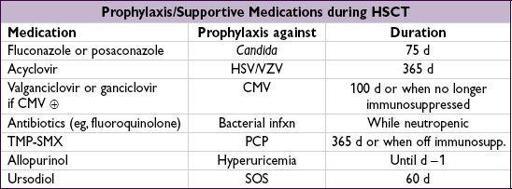Pocket Medicine: The Massachusetts General Hospital Handbook of Internal Medicine (75 page)
Read Pocket Medicine: The Massachusetts General Hospital Handbook of Internal Medicine Online
Authors: Marc Sabatine
Tags: #Medical, #Internal Medicine

BOOK: Pocket Medicine: The Massachusetts General Hospital Handbook of Internal Medicine
5.04Mb size Format: txt, pdf, ePub
Treatment
• Hyperviscosity:
plasmapheresis
• Symptoms (eg, progressive anemia): rituximab ± chemotherapy (eg, cyclophosphamide, chlorambucil, fludarabine, cladribine, bendamustine) or bortezomib • Thalidomide, alemtuzumab, everolimus, ibrutinib & auto-HSCT are investigational Rx
HEMATOPOIETIC STEM CELL TRANSPLANTATION (HSCT)
Transplantation of donor pluripotent cells that can reconstitute all recipient blood lineages
•
Types of Allo HSCT
:
based on donor/recipient matching of major HLA antigens on Chr. 6
(4 principal genes for serotyping:
HLA-A
,
-B
, -
C
, &
-DR
; each w/ 2 alleles ∴ 8 major Ag)
Matched related
(sibling matched at 8/8 major Ag): lowest risk of GVHD; preferred donor
Mismatched related
(eg, 1/8 Ag mismatch) or
haploidentical
(mismatch at 4/8 Ag): easiest to find, but ↑ risk of GVHD, rejection; ∴ need additional immunosuppression
Matched unrelated
: ↑ risk of GVHD; ∴ matching of 10 HLA alleles (
DQ
also
)
to ↓ risk; chance of match correlates w/ ethnicity
Umbilical cord blood
: HSC processed at birth & stored; ↓ risk of GVHD; tolerate mismatch but much slower immune reconstitution (
Blood
2010;116:4693)
•
Graft-vs.-host disease (GVHD)
:
undesirable
side effect of allo HSCT allogeneic T cells view host cells as foreign; ↑ incid. w/ mismatch or unrelated donors •
Graft-vs.-tumor (GVT)
effect:
desired
in allo-SCT; graft T cells attack host tumor cells
Indications
(
NEJM
2006;354:1813;
BMT
2010;45:1259)
•
Malignant disease
:
Auto HSCT
allows
higher ablative chemo doses
and then rescues the hematopoietic system (used mostly for lymphoma, multiple myeloma, testicular cancer)
Allo HSCT
produces
graft-versus-tumor
(GVT) effect, in addition to hematopoietic rescue (used for AML, ALL, CML, CLL, MDS, lymphoma)
•
Nonmalignant disease
: allo HSCT replaces abnl lymphohematopoietic system w/ one from nl donor (eg, immunodef., aplastic anemia, hemoglobinopathies, ? autoimmune dis.)
Transplantation procedure
•
Preparative regimen
:
chemotherapy
and/or
immunosuppression
prior to transplantation
myeloablative (traditional): chemotherapy and/or total body irradiation. Goal is
eradication
of underlying disease for which transplant is being performed.
reduced intensity conditioning (RIC or “mini”): lower dose conditioning → ↓ toxicity to allow Pts w/ comorbidities or ↑ age to tolerate HSCT. Goal to proceed w/ transplant when in disease remission. Depends mostly on GVT; ↓ mortality w/ RIC, but ↑ relapse.
•
Sources of stem cells
:
bone marrow (BM)
: original source of HSCT, now less commonly used than PBSC
peripheral blood stem cells (PBSC)
: easier collection, most commonly used source
BM vs. PBSCsurvival; BM ↓ chronic GVHD, PBSC ↓ graft failure (
NEJM
2012;367:1487)
umbilical cord blood (UCB)
: less stringent HLA-matching requirements, but fewer cells available from single donor (∴ 2 donors combined in adults); slower engraftment
haploidentical
: most available; newer regimens starting to make safer/more common
•
Engraftment
: absolute neutrophil count (ANC) recovers to 500/µL w/in
2 wk w/ PBSC,
3 wk w/ BM, ~4 wk w/ UCB. G-CSF accelerates recovery by 3–5 d in all scenarios.
Engraftment syndrome
: fever, rash, noncardiogenic pulm edema, abnl LFTs, AKI, wt gain. Dx of exclusion: r/o infection, GVHD; Rx w/ IV steroids.
Complications
• Either
direct chemoradiotoxicities
associated with preparative regimen or consequences of
interaction between donor and recipient immune systems
•
Sinusoidal obstruction syndrome (SOS):
incidence ~10%, mortality ~30%
Previously known as
veno-occlusive disease (VOD)
Mechanism: direct cytotoxic injury to hepatic venules →
in situ
thrombosis
Symptoms: tender hepatomegaly, ascites, jaundice, fluid retention with severe disease → liver failure, encephalopathy, hepatorenal syndrome
Diagnosis: ↑ ALT/AST, ↑ bilirubin; ↑ PT with severe disease; Doppler U/S
may
show reversal of portal vein flow; ↑ hepatic wedge pressure; abnl liver bx
Treatment: supportive; prophylaxis with
ursodiol
; defibrotide
•
Idiopathic pneumonia syndrome (IPS)
: up to 70% mortality (
Curr Opin Oncol
2008;20:227)
Mech: alveolar injury due to direct toxicity → fever, hypoxia, diffuse pulmonary infiltrates
Diffuse alveolar hemorrhage (DAH)
: subset of IPS
Diagnosis: bronchoscopy to exclude infection; ↑ bloody lavage fluid seen with DAH
Treatment: high-dose corticosteroids, etanercept (
Blood
2008;112:3073)
•
Acute GVHD
(usually within 6 mo of transplant;
Lancet
2009;373:1550)
Clinical grades I–IV based on scores for
skin
(severity of maculopapular rash),
liver
(bilirubin level) and
GI
(volume of diarrhea); bx supports diagnosis
Prevention:
immunosuppression
(MTX + CsA or tacrolimus) or T-cell depletion of graft
Treatment: grade I → none; grades II–IV → associated with ↓ survival and ∴ treated with immunosuppressants (corticosteroids, CsA, tacrolimus, rapamycin, MMF)
•
Chronic GVHD
(developing or persisting beyond 3 mo posttransplant)
Clinical: malar rash, sicca syndrome, arthritis, obliterative bronchiolitis, bile duct degeneration, cholestasis and many others. More common w/ PBSC than BM.
Treatment: immunosuppressants; rituximab; photopheresis
•
Graft failure
Primary = persistent neutropenia without evidence of engraftment
Secondary = delayed pancytopenia after initial engraftment; either immune mediated via immunocompetent host cells (
graft rejection
) or non–immune mediated (eg, CMV)
•
Infectious complications
due to regimen-induced pancytopenia and immunosuppression
auto HSCT recipients: no immunosuppression ∴ at ↑ risk only pre-/postengraftment
both primary infections and reactivation events occur (eg, CMV, HSV, VZV)
LUNG CANCER
(
NEJM
2008;359:1367;
JCO
2012;30:863;
J Thorac Oncol
2012;7:924;
Nature
2011;489:519;
Cell
2012;150:1107)
Epidemiology and risk factors
Other books
Mackenzie's Mission by Linda Howard
Warrior of the Isles by Debbie Mazzuca
Exhibition by Danielle Zeta
Hannah's Joy by Marta Perry
A Deal to Die For by Josie Belle
The Empty by Thom Reese
Vanishing Girls by Katia Lief
Set Change: A Nina Bannister Mystery (The Nina Bannister Mysteries) by T'Gracie Reese, Joe Reese
My Body-His by Blakely Bennett
APretenseofLove by Aileen Fish




